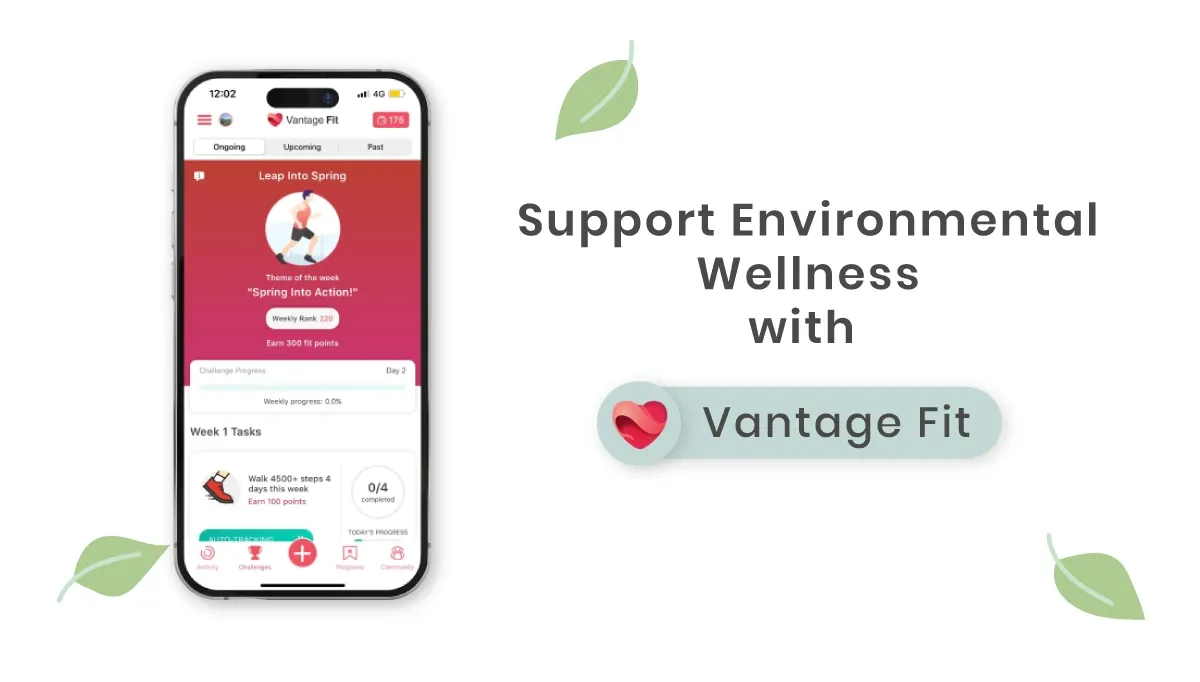Environmental Wellness in the Workplace: Importance & Strategies to Improve
A healthy workforce starts with a healthy environment.
From the air employees breathe to the lighting above their heads, the workplace shapes how people feel, think, and perform.
While mental health and ergonomics often take center stage in workplace wellness, environmental wellness should not be overlooked. When ignored, the impact is evident in burnout, fatigue, rising sick leave, and lower engagement.
Environmental wellness is about creating a space that supports both the body and mind through elements like clean air, proper lighting, and noise control. If your office feels stuffy, noisy, dim, or disconnected from nature, it is likely to affect both your wellbeing and productivity.
A Study by the United States Environmental Protection Agency show that indoor air can be five times more polluted than outdoor air.
Poor air quality, lighting, and noise can contribute to asthma, fatigue, and impaired focus. If your environment is draining your people, it is also draining your business. The good news is that most fixes do not need massive budgets or fancy upgrades.
Small, thoughtful changes, such as improving airflow, adjusting lighting, or encouraging screen breaks, can quickly boost energy, focus, and morale.
In this blog, we will explore what environmental wellness really means. We will look at why it matters for your team and your business. Finally, we will share practical steps to help you create a workplace where people feel better and perform at their best.
What is environmental wellness?

Environmental wellness refers to the state of a workplace that supports the physical and mental wellbeing of its people through healthy, safe, and thoughtfully designed surroundings. It encompasses everything from air quality, lighting, and temperature to noise control, ergonomics, and the management of digital distractions.
When these elements work together, employees feel more comfortable, focused, and energized throughout the day.
The stakes are high. According to the CDC and the WHO, poor indoor air quality is linked to asthma, heart disease, and even premature births. In many offices, stale air, chemical pollutants, and inadequate ventilation can silently impact employee health and energy levels.
Environmental wellness is not just about physical health; it also influences mental clarity, focus, and emotional wellbeing. Harsh lighting, constant background noise, or uncomfortable workstations can lead to mental fatigue, stress, and reduced concentration. Over time, these conditions contribute to burnout, disengagement, and high turnover.
On the flip side, natural light can be a game changer. Studies show that exposure to daylight improves sleep quality, boosts mood, and increases productivity. When people work in a well-lit, fresh, and calming environment, they tend to perform better and stay engaged.
Also read: 12 Green Office Design Ideas for 2025: Sustainable Workspace Solutions That Boost Productivity
Environmental wellness also connects with sustainability. Buildings account for nearly 28 percent of global CO₂ emissions. Making smarter choices, such as switching to energy-efficient lighting, optimizing ventilation, and reducing waste, can make your office both eco-friendly and employee-friendly at the same time.
In short, when your workplace environment supports your people, it also supports your business.
26 Proven Benefits of Environmental Wellness in the workplace
Environmental wellness does more than create a comfortable atmosphere; it fosters a healthier lifestyle. It directly improves employee health, cuts operational costs, strengthens your brand, and reduces your environmental footprint. Here's how it adds measurable value across every level of your organization:
Health & Wellbeing Benefits

- Reduced risk of chronic diseases such as asthma, heart disease, and bronchitis
- Lower premature birth rates among employees exposed to better air quality
- Improved air quality that helps reduce respiratory issues and allergies
- Stress reduction through nature exposure and calming, clutter-free spaces
- Improved creativity and problem-solving through better lighting and quieter environments
- Better focus and concentration by minimizing distractions and discomfort
- Increased energy and vitality supported by access to natural light and fresh air
- A stronger connection to nature which promotes emotional wellbeing and balance
Financial Benefits

- Reduced healthcare costs through preventative measures and fewer claims
- Lower insurance premiums due to healthier and safer workplace conditions
- Reduced absenteeism and increased presenteeism as employees fall sick less and perform better
- Lower operational expenses from energy-saving systems such as LED lighting (up to 90 percent savings)
- Reduced waste disposal costs through better recycling and low-waste practices
- Cost savings through remote work setups that cut utility and infrastructure spending
- Improved employee retention by aligning workplace values with employee expectations
Business Advantages

- Enhanced brand reputation as a sustainability-forward, employee-first organization
- Greater investor attraction from ESG-conscious backers and boards
- Stronger competitive differentiation through healthier, more appealing workspaces
- Increased employee engagement supported by wellness-first initiatives
- Better team collaboration driven by improved mood, comfort, and energy at work
- Improved productivity and retention backed by research from Harvard showing a 61% rise in cognitive function and a 28% drop in turnover in wellness-optimized workplaces
Environmental Impact

- Lower CO₂ emissions by using energy-efficient systems and reducing overconsumption
- Reduced landfill waste through material reuse, recycling, and waste-conscious habits
- Support for green commuting and hybrid models that reduce fuel usage
- Foster a culture of sustainability reinforced through team-led environmental activities and everyday green habits
- Better alignment with ESG goals through measurable, people-focused environmental practices
Now that we've seen how environmental wellness pays off across every level of your business, let's explore how you can put it into action with practical, high-impact strategies.
Ways to Improve Environmental Wellness in the Workplace
Improving environmental wellness doesn't always require a significant investment. It begins with simple, thoughtful changes that create a healthier, more focused, and more energizing work environment. Below are five key areas where you can work.
Physical Environment Improvements

The physical setup of your office plays a significant role in how your employees feel throughout the day. When comfort, cleanliness, and natural elements come together, productivity and morale follow.
Maximize natural light exposure by positioning desks near windows and using reflective surfaces to extend daylight deeper into the workspace. Where possible, consider installing skylights or daylight sensors that adapt indoor lighting to match outdoor brightness.
Enhance air quality with indoor plants such as peace lilies or snake plants and use air purifiers to remove pollutants. Keep HVAC systems well-maintained and make sure air vents aren't blocked. Setting clear no-smoking zones also helps maintain healthier air indoors.
Also Read: Indoor Air Quality at Work – Importance & Ways to Improve it
Add green spaces through indoor plant walls, small outdoor gardens, or even nature-themed artwork. These elements bring calm to high-stress areas and create more inviting communal spaces.
Support ergonomic health with adjustable desks, chairs with proper lumbar support, and monitor stands to reduce eye and neck strain. Offering guidance on workstation setup can also prevent long-term physical discomfort.
Control noise by using acoustic panels, carpeting, or white noise systems. Provide quiet zones or phone booths for focused work and private calls, especially in open-plan offices.
Digital Environment Optimization

A healthy digital space is just as important as a physical one, especially with hybrid work becoming the norm. Without boundaries, digital tools can become a significant source of fatigue.
Set digital wellness policies that limit after-hours emails, encourage meeting-free focus time, and remind employees to take regular screen breaks. These small shifts help reduce mental overload and maintain a healthy work-life balance.
Utilize wellness-focused tools and apps, such as Vantage Fit to foster healthier digital habits. Encourage employees to step away from their screens during breaks or participate in virtual mindfulness sessions to reset throughout the day.
Sustainability Initiatives

Sustainability benefits both the planet and your people by fostering a sense of purpose and reducing environmental impact.
Launch energy conservation efforts by switching to LED lighting, installing smart thermostats, and investing in energy-efficient appliances. These not only reduce your carbon footprint but also improve workplace comfort.
Promote waste reduction through well-labeled recycling stations, paperless workflows, and the use of reusable office supplies. Composting food waste and switching to eco-friendly cleaning products also make a visible difference.
Practice water conservation by using low-flow fixtures, drought-resistant landscaping, and regularly scheduled maintenance checks to prevent waste from leaking or being overused.
Employee Engagement Activities

Wellness programs are most effective when employees participate in shaping them. Engaged teams are more likely to adopt and stick with healthy habits.
Host wellness challenges like zero-waste months, bike-to-work weeks, or energy-saving competitions. A little friendly competition helps turn new habits into routine.
Encourage community involvement through tree planting, local clean-ups, or partnerships with sustainability-focused nonprofits. These experiences build team spirit while reinforcing your company's values.
Keep employees informed through awareness campaigns, such as lunch-and-learn sessions, sustainability workshops, or weekly eco-tips. Education is key to maintaining momentum.
Remote Work Considerations

Environmental wellness shouldn't stop at the office. Support your remote team with the same care and attention.
Offer home office support through ergonomic equipment allowances or setup guides. Encourage the use of natural light, indoor plants, and proper ventilation for a healthier environment.
Run virtual programs like step challenges, guided meditations, or walking meetings. These help remote employees stay connected to both the team and their wellbeing goals.
Now, let's take a closer look at how to assess your current environment with a simple, actionable checklist.
How Does Vantage Fit Support Environmental Wellness?

Vantage Fit helps companies bring environmental wellness to life through everyday actions. Actions that are easy to track, encourage, and scale. The platform supports mindful screen use and movement routines.
This integrates wellness seamlessly into the employee experience, encouraging healthier habits. Our recent Cycle Commute Challenge is a great example. In celebration of World Environment Day, employees were encouraged to ditch their vehicles and bike to work, combining physical activity with a reduced carbon footprint.

Challenges like these motivate teams to take charge of both their health and the planet's wellbeing.
Ready to integrate environmental wellness into your employee experience? Connect with us today to support your wellness goals.
FAQs
1) How to create an eco-friendly workplace?
You can create an eco-friendly workplace by reducing energy and water consumption, incorporating indoor plants, using sustainable office supplies, promoting recycling, and encouraging green commuting habits among employees.
2) What are some examples of environmentally sustainable work practices?
Using LED lights, going paperless, setting up recycling bins, conserving water, reducing plastic use, and switching to energy-efficient equipment are all effective practices that can help reduce environmental impact.
3) How can poor environmental conditions affect employee health?
Poor environmental conditions can cause stress, fatigue, and breathing issues, leading to burnout, absenteeism, and low job satisfaction.
4) What actions can employees take to improve environmental wellness in the workplace?
They can reduce waste, switch off unused devices, use reusable items, report inefficiencies, and join wellness challenges or sustainability drives organized by the company.




